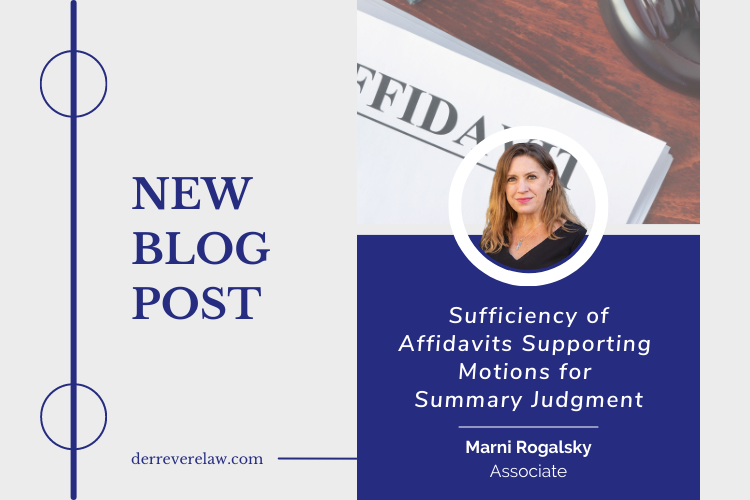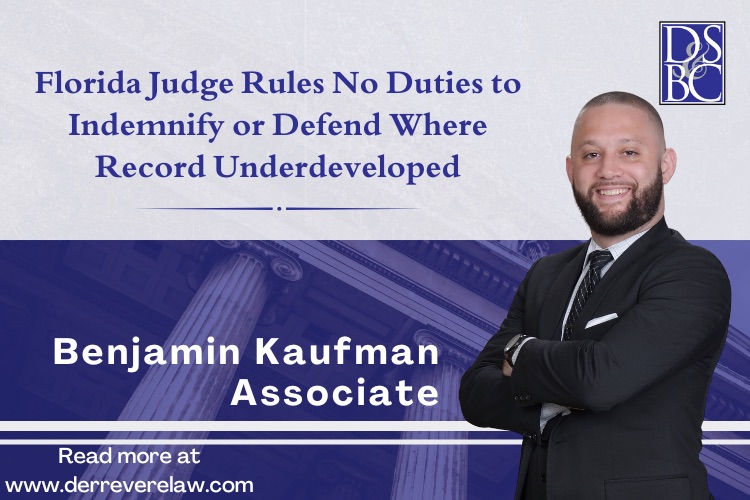Sufficiency of Affidavits Supporting Motions for Summary Judgement

Motions for Summary Judgment are a useful tool for insurance companies to have a Court rule on issues in a case as a matter of law before those issues are presented to a jury. In the context of defending first-party property cases, oftentimes these motions are filed and rely on affidavits of various witnesses – the carrier’s Corporate Representative, a field adjuster, or possibly an expert witness. What happens if the field adjuster or expert witness are not able to provide an affidavit in support of summary judgment? Can the insurance company’s Corporate Representative attest to photographs or other documents, such that they can be accepted as record evidence by a Court in ruling on a Motion for Summary Judgment? In short, the answer is “yes;” however, there is necessary information that must be included in the affidavit so that it is in compliance with the Florida Rules of Evidence and of Civil Procedure.
First and foremost, a Motion for Summary Judgment can only be granted where the record evidence, including pleadings (such as an Answer that admits certain allegations of a Complaint), discovery responses (such as verified Answers to Interrogatories), deposition testimony, and affidavits, reflect that no reasonable juror could find for the non-moving party. As the U.S. Supreme Court has described it, “[T]he basic issue before the court on a motion for summary judgment is ‘whether the evidence presents a sufficient disagreement to require submission to a jury or whether it is so one-sided that one party must prevail as a matter of law.” Anderson v. Liberty Lobby, 477 U.S. at 242 (1986). In other words, if the evidence is such that a reasonable jury could return a verdict for the nonmoving party, summary judgment should not be granted. Id.
Because the facts in dispute are rarely established solely by the pleadings or discovery responses, it is imperative that the affidavits filed with the motion are properly drafted so that they can avoid being stricken. Bear in mind that an affidavit is the attestation of a witness – sworn to under oath – just as if testimony was given at a trial. As such, the same rules for admissibility apply to affidavits as would the testimony given by a witness at trial, and the first rule for admissibility of a witness’s testimony is that he or she must have personal knowledge of the matters as to which they are offering testimony. Attestations in a Corporate Representative’s affidavit must be more than mere conclusions, otherwise, it will be stricken as hearsay.
The Florida Rules of Evidence and of Civil Procedure will allow a Corporate Representative to testify as to facts or offer documents from the claim file if those documents are business records of the company, or if the information is known to the Corporate Representative because it is information kept as a business record. It is not sufficient though to simply attest to a document or any specific information being a “business record.” Florida Rule of Evidence 90.803(6) specifies the criteria to be met for a document to be considered a business record and thus not excluded from evidence as hearsay, which are: (1) it must be made at or near the time of the events being described, recounted, or recorded in the document, (2) it was made by, or from information transmitted by, a person with knowledge of those events, (3) it was kept in the course of a regularly conducted business activity, and (4) it was the regular practice of that business to make or maintain such a document or documents. As an example, for a field adjuster’s photographs to be admissible in a Motion for Summary Judgment without having an affidavit from the field adjuster, the Corporate Representative must attest that the photographs were taken during the course of the field adjuster’s inspection and uploaded to the file at or virtually immediately following the inspection, that they were taken by the field adjuster who performed the inspection, that they are kept in the normal course of the insurer’s business of conducting inspections for the purpose of evaluating claims, and that it was the insurer’s regular practice to maintain such photographs in its claim file.
In addition to establishing the admissibility of evidence as a business record, the Corporate Representative must demonstrate that they are qualified to provide the necessary information. Here though, the Courts are more lenient, requiring only that a Corporate Representative have working knowledge of the relevant record-keeping practices and system of the company whose records they seek to have introduced. They do not need to be the person who created the records, they do not have to have personally witnessed the documents being created, nor do they even have to testify regarding the basis for their knowledge. They simply must have personal knowledge of the company’s regular business practices in regard to keeping and maintaining records. Therefore, it is not necessary for a manager or other high-level company employee to provide testimony, or even for the witness to have any particular length of employment. As such, whoever is handling the claim can qualify as a Corporate Representative for purpose of establishing the admissibility of photographs, correspondence, and other documents from the claim file. So long as they have training in the business practices of the company or otherwise can testify in regard to the above factors, the Courts will accept their testimony. Jackson v. Household Finance Corp., Case No. SC18-357 (Fla. 2020).
This issue was recently addressed in Mesa v. Citizens Prop. Ins. Corp., No. 3D22-398, 2 (Fla. Dist. Ct. App. Mar. 1, 2023). In that case, a jury rendered a verdict in favor of the insurance company, which was overturned on appeal. The appellate court found that the carrier’s primary rebuttal evidence was based on inadmissible hearsay testimony from Citizens’ Corporate Representative, who admitted that she had no personal knowledge of the facts upon which she was testifying. The carrier’s field adjuster did not testify at trial, and the carrier did not attempt to introduce documents prepared by the field adjuster as a business record. While on the stand, the Corporate Representative was allowed to discuss the contents of a field adjuster’s report and photographs. On appeal, the Third District Court of Appeal found that the Corporate Representative’s testimony should not have been introduced to the jury, as it was inadmissible hearsay for which no exception was introduced.
Ultimately, the purpose of a Motion for Summary Judgment is to try to resolve a case early and to narrow the issues to be addressed at trial. However, for the Motion to be viable, it has to rely on evidence set forth in the record or provided with the Motion. Affidavits are critical in supporting the arguments addressed in a Motion for Summary Judgment. As seen in the Mesa case, a Corporate Representative cannot simply attest to documents being in a claim file for them to be admissible as evidence by the trial court. As such, it is critical that an attorney be familiar with the rules of evidence and civil procedure in order to draft legally sufficient affidavits to support a Motion for Summary Judgment as well as to be able to respond to any challenges to the evidence that may be presented by an opposing counsel.




